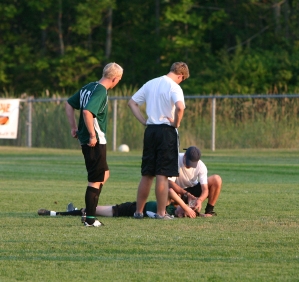Underreporting of Concussion By High School Athletes Continues Despite Increased Education
As many as four out of ten of possible concussions sustained by high school athletes are never reported to a coach or medical professional, with only one in seven concussions considered ‘bell-ringers’ reported, finds a 2013 study. [1]
Researchers at WakeMed Health and Hospitals, Raleigh, NC, the University of North Carolina at Chapel Hill, and A.T. Still University in Mesa, Arizona found that, while athletes are generally knowledgeable about the signs and symptoms of concussion, there is a “gross underreporting” of concussion events, with a large proportion of those surveyed indicating that they continued to participate in both games and practices while experiencing symptoms.
“Most strikingly,” writes Johna Register-Mihalik, Ph.D, LAT, ATC, Senior Research Associate at WakeMed and Adjunct Assistant Professor at UNC-Chapel Hill, “athletes only indicated reporting 13% of events they considered bell ringers, which were likely concussive injuries.”
The concern, she writes, is that “athletes not reporting these bell-ringer events may have continued to participate or returned to participation too early, predisposing them to further injury.”
“We were not overly surprised” by the low rate of reporting bell-ringer events, Register-Mihalik told MomsTEAM, because previous studies have shown that “terminology around concussion is an issue, [with] the terms ‘bell ringer’ and ‘ding’ having different meaning to various individuals. Certainly, the culture of the ‘warrior mentality’ plays a role in not reporting these events,” she observed, “but some of it is also an awareness issue, and we have a great opportunity, with so much attention around concussion, to increase knowledge in this area.
One of our recommendations is that we remove these terms from the discussion of concussion so as to not minimize concussion as anything other than a brain injury. All of these events are likely not concussions, but individuals should be aware enough to know that they should let someone know that a potential concussive event has occurred and move forward from that direction.”
Tamara Valovich McLeod, , PhD, ATC, FNATA, Professor in the Athletic Training Program and Directors of the Interdisciplinary Research Laboratory, and Athletic Training Practice-Based Research Network in the Department of Interdisciplinary Health Sciences at A.T. Still University in Mesa, Arizona, noted that some of her previous work[6] had shown a higher rate of reporting when terms like “ding”and “bell-rung” were included. “We do need to educate that those events, even though they may seem inconsequential, need to be reported and evaluated by a healthcare provider. I’d rather err on the side of caution and remove a child to evaluate him/her than miss a concussion and have a catastrophic event.”
Despite increased concussion education, the underreporting rate of approximately 40% for perceived concussions the researchers found was not substantially better than the 50% underreporting rate found in previous studies over the last decade. [2,3,4]
Knowledge doesn’t increase reporting
Although some studies have examined knowledge and attitude towards concussion [5,6,7], few quantitative studies have examined the influence of concussion knowledge on reporting frequency, and few prior studies have examined overall attitudes concerning concussion and reporting of possible concussion among high school athletes.
To test the hypothesis that better knowledge about concussions and attitudes towards reporting concussion symptoms are associated with higher rates of reporting, researchers surveyed 1669 high school athletes in 6 sports (football, cheerleading, boys’ and girls’ soccer, boys’ or girls’ lacrosse) at 25 U.S. high schools over the period November 2008 to February 2010 [before many of the so-called Lystedt laws were passed by almost U.S. states requiring mandatory concussion education as a condition for sports participation]. To model the reality that less than 50% of U.S. high schools have access to an athletic trainer [11] (recent statistics [17] from the National Athletic Trainers’ Association suggest that the percentage has ticked up to about 70%), 15 of the schools had daily access to an AT, while 10 did not.
167 14- to 18-year-old athletes (10% of the total) completed a 35-question survey testing their concussion symptom recognition, knowledge of complications related to multiple concussions, and general concussion knowledge (see chart below). Athlete attitude was assessed with 14 questions about overall attitude towards concussion, concussion education, and concussion reporting on a 7-point scale, with 1 signifying no agreement and 7 indicating complete agreement (see chart)
To assess recalled concussion events and reporting during high school, athletes were asked how many concussions they think they had experienced during high school, how many of the possible concussions they reported to medical professional or coach, and, as a way of assessing when possible concussion occurred, were also asked how many times they had their ‘bell rung’ or had been ‘dinged.’
Because the study was based on personal perceptions, no definition of the term ‘bell ringer’ was given, but the term is commonly used to describe brief, transient alterations in neurololgic function, not all of which may have been true concussions but which warranted examination before an athlete should be allowed to return to play.
Finally, athletes were asked about their reporting behaviors, and why they had not reported possible concussion or bell-ringer events.
Here’s what the researchers found:
- A total of 89 athletes (53.3%) recalled having at least one possible concussion or bell-ringer event during their high school years. Of the 89 athletes, only 15 (16.9%) said they reported all concussive bell-ringer events to a coach or medical professional;
- Of the 84 recalled concussions, only 41 (48.8%) were reported to a coach or medical professional;
- Participants recalled a total of 584 bell-ringer events; of these only 72 (12.3%) were reported;
- Athletes reported only 22.8% of concussion or bell-ringer events to a coach or medical professional which occurred during games.
- Of the 348 concussion or bell-ringer events occurring during practice, only 40 (11.5%) were reported;
- 37.7% of the athletes indicated that they had continued participating in a practice or game at least once while experiencing signs and symptoms of concussion.



